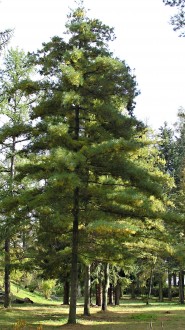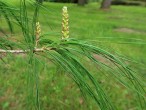(Pinus armandii Franchet)
Habitus
- tree growing to a height of 15 - 25 m
- crown wide conical when young, later flat, spreading
- branches in whorls, long, horizontally protruding
- bark gray, smooth
Leaves (assimilation organs)
- assimilation organs are needle-like
- needles are thin, 8 - 15 x 0.1 cm in size, slightly serrate at the edges, triangular in cross-section
- grouped by 5 on brachyblasts (section Strobus) !
- on branches are relatively sparsely grouped, they last 2 - 3 years on a branch
Flowers
- wood is monoecious, flowers are unisex, blooms V – VI
- ♂ cones are cylindrical, 10–12 mm long, light yellow, grouped at the base of this year's shoots
- ♀ cones are 12–15 x 4 – 5 mm large, oblong ovoid, pink to reddish (later purple) on an 8 – 10 mm long stem, they grow singly, but also in whorls of 2 – 3 at the end of this year's shoots
Fruits – seeds
- fruit is a cone 10 - 15 x 7 - 8 cm large, oblong-conical, green before ripening, yellow-brown after ripening
- the labels are wrinkled on the surface
- the umbilicus is on the lower edge of the label (section Strobus)
- the seed is 10 - 12 x 4 - 5 mm large, ovoid, compressed with a sharp edge, wingless (only with a small blank)
Extension
- China (Tibet, Taiwan), northern Myanmar
- grows in mountainous areas and river basins, depending on the location at altitudes from 900 – 3,500 m above sea level
- does not form homogeneous stands, mostly it is part of stands formed by species of the genus Picea, Abies, Larix, Pseudotsuga, Pinus, Tsuga, ...
Ecology
- it is a sunny woody plant that does not tolerate shading
- grows well on acidic soils (up to neutral pH soils)
- partially frost-resistant (up to - 17 °C)
Significance
- decorative tree with habit, long needles, but also fruits - cones

















